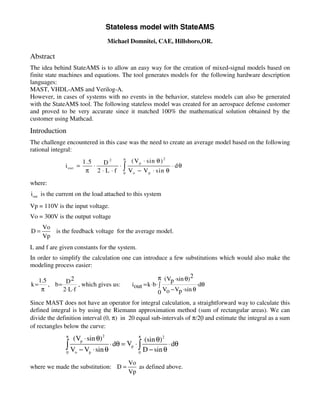
STATELESS Stateless Model Approximates Integral
- 1. Stateless model with StateAMS Michael Domnitei, CAE, Hillsboro,OR. Abstract The idea behind StateAMS is to allow an easy way for the creation of mixed-signal models based on finite state machines and equations. The tool generates models for the following hardware description languages: MAST, VHDL-AMS and Verilog-A. However, in cases of systems with no events in the behavior, stateless models can also be generated with the StateAMS tool. The following stateless model was created for an aerospace defense customer and proved to be very accurate since it matched 100% the mathematical solution obtained by the customer using Mathcad. Introduction The challenge encountered in this case was the need to create an average model based on the following rational integral: 1.5 D 2 π (V p ⋅ sin θ ) 2 π 2 ⋅ L ⋅ f ∫ V o − V p ⋅ sin θ i out = ⋅ ⋅ ⋅ dθ 0 where: i out is the current on the load attached to this system Vp = 110V is the input voltage. Vo = 300V is the output voltage Vo D= is the feedback voltage for the average model. Vp L and f are given constants for the system. In order to simplify the calculation one can introduce a few substitutions which would also make the modeling process easier: π (Vp ⋅sin θ)2 k= 1.5 , b= D 2 , which gives us: iout = k ⋅ b ⋅ ∫ ⋅ dθ π 2 ⋅ L ⋅f 0 Vo − Vp ⋅sin θ Since MAST does not have an operator for integral calculation, a straightforward way to calculate this defined integral is by using the Riemann approximation method (sum of rectangular areas). We can divide the definition interval (0, π) in 20 equal sub-intervals of π/20 DQG HVWLPDWH WKH LQWHJUDO DV D VXP of rectangles below the curve: π (Vp ⋅ sin θ) 2 π (sin θ)2 ∫ Vo − Vp ⋅ sin θ ⋅ dθ = Vp ⋅ ∫ D − sin θ ⋅ dθ 0 0 Vo where we made the substitution: D = as defined above. Vp
- 2. Modeling process Using the sum of rectangular areas, the rational integral can be approximated as follows: i π (sin π)2 (sin θ) 2 π 20 20 ∫ D − sin θ ⋅ dθ = 20 i∑1 = i π 0 D − sin π 20 At this point in time we can see that the original problem has become: i (sin π)2 π 20 20 iout = k ⋅b⋅ ∑ π 20 i =1 i D − sin π 20 The system requirements point to a model topology with 3 conservative ports: - input voltage (Vp) - output voltage (Vo) - feedback (duty) voltage Since b and D depend on the input and output voltages, they will be defined as continuous variable. Our main continuous variable is i out which is the sum of the 20 components (i1,i2,…i20). The static variables of our model are: - n (the number of sub-intervals) - π (defined as 3.14) - L, f, and k are constants which have been introduced in the beginning. There are no states defined or specified for the behavioral description of this model. However, with all the information provided, we can create a stateless model using StateAMS tool. Following is the template auto-generated by the StateAMS tool: # Created with StateAMS 1.5. element template integral in out vduty = pi, n, l, f electrical in, out, vduty number pi=3.14159, n=20, l=18e-6, f=50e3 { val v vp, vo, duty val i iout val nu i1, i2, i3, i4, i5, i6, i7, i8, i9, i10, a, b, i11, i12, i13, i14, i15, i16, i17, i18, i19, i20 number k parameters { k=1.5/pi } values { vp=v(in) vo=v(out) duty=v(vduty) a=vo/(vp+1p) b=0.5*duty**2/l/f i1=sin(pi/n)**2/(a-sin(pi/n)) i2=sin(2*pi/n)**2/(a-sin(2*pi/n)) i3=sin(3*pi/n)**2/(a-sin(3*pi/n)) i4=sin(4*pi/n)**2/(a-sin(4*pi/n)) i5=sin(5*pi/n)**2/(a-sin(5*pi/n)) i6=sin(6*pi/n)**2/(a-sin(6*pi/n)) i7=sin(7*pi/n)**2/(a-sin(7*pi/n)) i8=sin(8*pi/n)**2/(a-sin(8*pi/n)) i9=sin(9*pi/n)**2/(a-sin(9*pi/n)) i10=sin(10*pi/n)**2/(a-sin(10*pi/n))
- 3. i11=sin(11*pi/n)**2/(a-sin(11*pi/n)) i12=sin(12*pi/n)**2/(a-sin(12*pi/n)) i13=sin(13*pi/n)**2/(a-sin(13*pi/n)) i14=sin(14*pi/n)**2/(a-sin(14*pi/n)) i15=sin(15*pi/n)**2/(a-sin(15*pi/n)) i16=sin(16*pi/n)**2/(a-sin(16*pi/n)) i17=sin(17*pi/n)**2/(a-sin(17*pi/n)) i18=sin(18*pi/n)**2/(a-sin(18*pi/n)) i19=sin(19*pi/n)**2/(a-sin(19*pi/n)) i20=sin(20*pi/n)**2/(a-sin(20*pi/n)) iout=pi*vp*b*k*(i1+i2+i3+i4+i5+i6+i7+i8+i9+i10+i11+i12+i13+i14+i15+i16+i17+i18+i19 +i20)/n } equations { i(out)+=iout } }